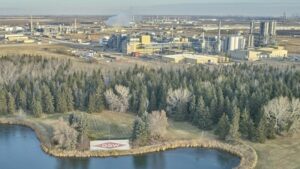
Dow proceeding with $6.5-billion Path2Zero project in Alberta
Canadian Plastics
Canadian Plastics Construction Materials SustainabilityThe project will be the world's first ethylene cracker and downstream derivatives unit with net-zero Scope 1 and 2 emissions.

Aerial photograph of Dow’s manufacturing site in Fort Saskatchewan, Alta. Photo Credit: Dow Inc.
Chemical giant Dow Inc. says that its board has approved investment in the US$6.5-billion Path2Zero project in Fort Saskatchewan, Alta., as part of the firm’s goal of becoming carbon neutral by 2050.
In a Nov. 28 news release, Dow officials said the project – which includes building a new ethylene cracker and increasing polyethylene (PE) capacity by 2 million metric tonnes per annum – will be the world’s first ethylene cracker and downstream derivatives unit with net-zero Scope 1 and 2 emissions.
The project will leverage US$2-billion in additional investment from third parties for circular hydrogen, CO2 capture, and other infrastructure assets.
The company plans to begin construction in 2024. Capacity additions are expected to come online in phases, with the first phase starting up in 2027 and the second phase starting up in 2029.
“This new capacity will enable [us] to capture growing customer demand in high-value markets, such as packaging, infrastructure and hygiene, among others, with potential additional value captured from commercializing low and zero-emissions products,” the release said. “The project builds on [our] expertise in successfully implementing large projects, such as the TX-9 cracker in Freeport, Texas, which has delivered more than 15 per cent return on invested capital since its 2017 start-up through best-in-class capital intensity, conversion cost, and low emissions intensity.”
To achieve net-zero Scope 1 and 2 emissions, Dow said, the Fort Saskatchewan Path2Zero project will deploy Linde’s air separation and autothermal reformer technology to convert the site’s cracker off-gas to hydrogen, which will be used as a clean fuel to supply the site’s furnaces. In addition, carbon dioxide emissions will be captured and stored, reducing existing emissions.
Dow also said that it selected the Fort Saskatchewan site for this investment because Western Canada offers “highly cost-competitive natural gas relative to other regions,” as well as cost-advantaged ethane, a key feedstock for ethylene production. At full run-rates, Dow said, the site is expected to be one of the company’s most cost-competitive in the world. The region also features access to existing CO2 transportation and storage infrastructure with available capacity to fully support decarbonization of the project. Dow has operated in the area for more than 60 years.
Additionally, Dow said, the governments of Canada, Alberta, and Fort Saskatchewan have made subsidies and incentives available to support the project, which will be the first project to access Canada’s new Clean Tech ITC program, which encourages the investment of capital in the adoption and operation of clean technology property.
“The project serves as a leading example that industrial decarbonization is both possible and profitable,” Dow Chairman and CEO Jim Fitterling said. “The opportunity to decarbonize our assets while driving growth is central to [our] business strategy.”
